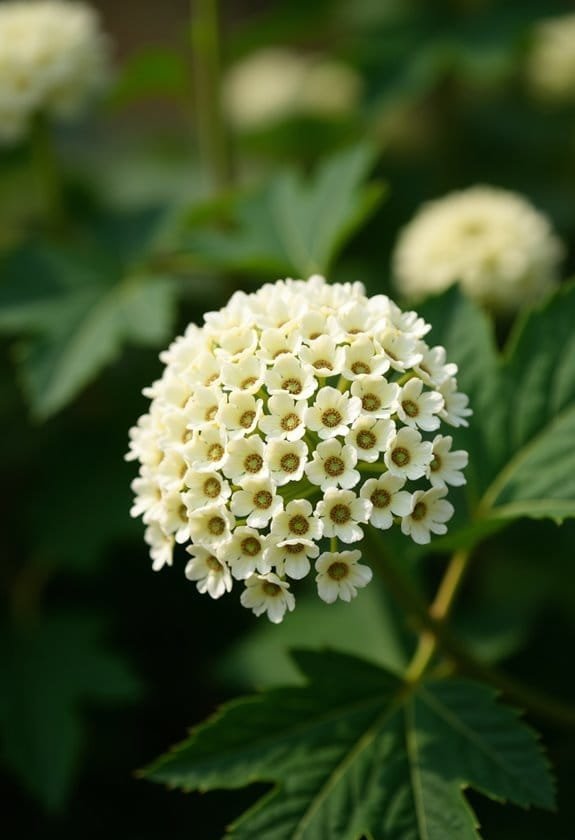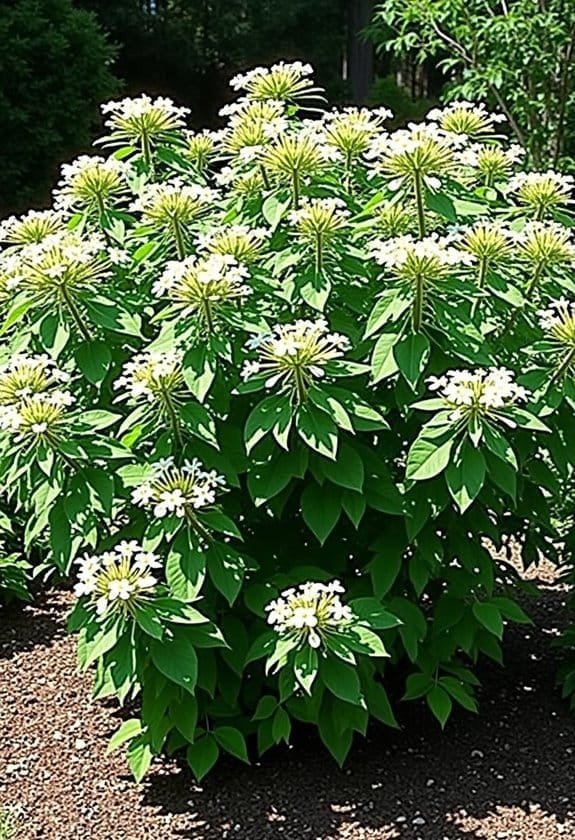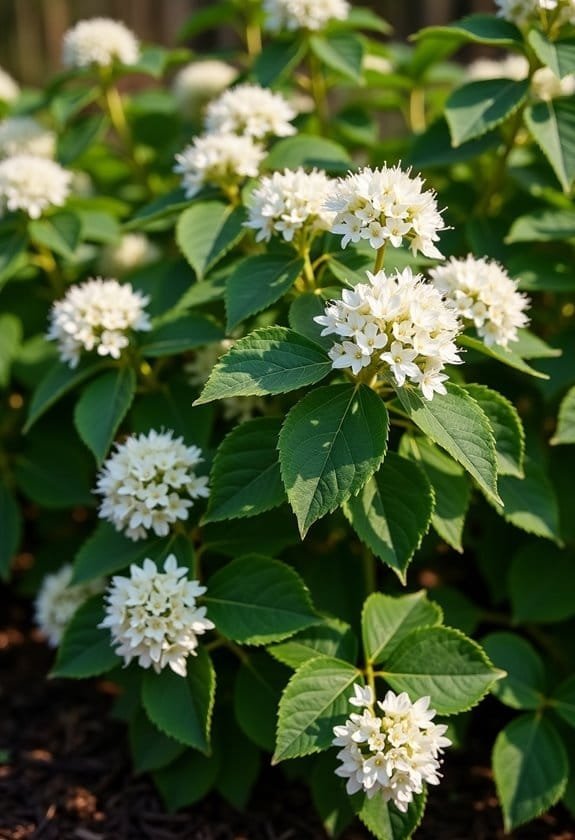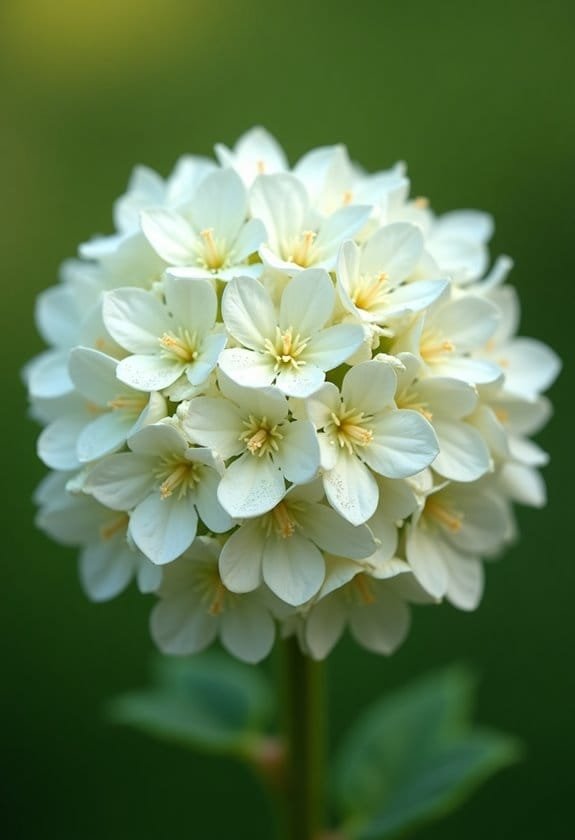Viburnum opulus, commonly known as Guelder Rose, is a striking deciduous shrub reaching heights of 4-5 meters with a rounded silhouette. It's prized for its three-lobed leaves, showy clusters of creamy-white flowers blooming from May to July, and bright red berries that persist through winter. The plant thrives in both full sun and shade, requiring moist, well-draining soil and temperatures between 15-25°C. Culturally significant as "Kalyna" in Ukraine, it serves as both an ornamental showpiece and crucial wildlife resource. This versatile shrub's year-round appeal and ecological benefits make it an intriguing addition to any landscape design.
Main Points
- Viburnum opulus is a deciduous shrub growing 4-5 meters tall, known for its creamy-white flowers and bright red berries.
- Originally from Gelderland, Netherlands, it holds cultural significance as "Kalyna" in Ukraine, symbolizing beauty and national pride.
- The plant produces showy flower clusters 4-11cm wide from May to July, followed by red berries lasting through winter.
- It thrives in moist, well-draining soil and adapts to various light conditions, tolerating temperatures as low as -15°C.
- The shrub serves as vital wildlife habitat, providing food for birds and shelter for pollinators throughout the year.
Introduction

Viburnum opulus, commonly known as guelder rose, stands as a remarkable deciduous shrub native to the United Kingdom and parts of Europe.
The species showcases its ornamental value through impressive clusters of creamy-white flowers that transform into vibrant red berries, making it a prized addition to both wild landscapes and cultivated gardens.
While its scientific classification places it within the Adoxaceae family, this versatile shrub has earned recognition for its ecological significance as a crucial food source for wildlife and its traditional use in both ornamental and culinary applications.
Common Name
The Guelder Rose (Viburnum opulus) is widely recognized by several common names, including dogberry, water elder, and cramp bark. The diverse nomenclature reflects both the plant's physical characteristics and its traditional uses across different regions and cultures.
The name "Guelder Rose" itself originates from Gelderland, a Dutch province where a cultivated variety of this ornamental shrub gained particular prominence. Despite its rose-like appearance when in bloom, it's not actually related to true roses, belonging instead to the honeysuckle family.
In Ukrainian culture, where the plant holds special significance, it's known as "Kalyna" and serves as a powerful symbol of beauty and national pride.
The designation "water elder" stems from the shrub's preference for damp habitats and its superficial resemblance to the elder plant, while "cramp bark" refers to its historical medicinal applications.
These varied names demonstrate how Viburnum opulus has woven itself into different aspects of human experience, from practical uses to cultural symbolism, across its native range in Europe and Asia.
Scientific Name
Scientifically identified as Viburnum opulus, this ornamental shrub carries a binomial name that precisely places it within the Adoxaceae family. The generic name "Viburnum" encompasses a diverse group of flowering plants, while "opulus" specifically distinguishes this species from its botanical relatives.
Throughout its taxonomic history, the Guelder rose has been known by several botanical synonyms, including Opulus edulis and Opulus glandulosa, reflecting the evolving understanding of its classification. These historical names provide valuable insight into the plant's taxonomic journey within the scientific community, ultimately leading to its current placement in the Viburnum genus.
The scientific designation accurately describes a deciduous shrub that reaches impressive heights of 4-5 meters, characterized by its distinctive three-lobed leaves and clusters of creamy-white to pink flowers.
This systematic classification helps botanists and horticulturists identify the species across its native range, which spans from Europe to various parts of Asia, where it frequently inhabits damp environments along riverbanks and established hedgerows.
Overview
Known for its striking appearance and ecological significance, guelder rose stands as a remarkable deciduous shrub that enhances both gardens and natural landscapes across Europe and Asia.
This versatile ornamental plant reaches impressive heights of 4-5 meters, featuring distinctive three-lobed leaves and producing clusters of delicate creamy-white or pink blooms from May through July.
The shrub's most enchanting feature emerges in autumn when it displays clusters of translucent, bright red berries that transform the plant into a seasonal showpiece.
While these berries require cooking for safe human consumption, they serve as a crucial food source for various bird species throughout the colder months.
Thriving in damp conditions and adaptable to both neutral and chalky soils, guelder rose has established itself as a cornerstone species in diverse habitats, from riverside environments to traditional hedgerows.
Beyond its ornamental appeal, this remarkable plant holds profound cultural significance, particularly in Ukraine, where it's celebrated as the national plant and serves as a symbol of natural beauty and cultural heritage.
Key Features
Viburnum opulus stands as an impressive deciduous shrub, reaching heights of 4 to 5 meters with a substantial spread of 2 to 4 meters at maturity.
The plant's distinctive three-lobed leaves, measuring 5 to 10 cm in length, showcase coarsely serrated margins that transform into vibrant orange-yellow or red hues during autumn.
From May through July, the shrub produces elegant clusters of creamy-white or pink flowers, featuring an arrangement of larger sterile blooms surrounding smaller fertile ones, which later develop into bright red berries.
Growth Size
The stately Guelder Rose towers impressively in gardens and natural settings, reaching heights of 4-5 meters (13-16 feet) with an equal spread of 2-5 meters (6.5-16 feet). This substantial growth size makes it an ideal specimen plant for larger landscapes, where its commanding presence can serve as a natural privacy screen or focal point.
The shrub's architectural form develops gradually over several growing seasons, establishing a rounded to vase-shaped silhouette that adds year-round structural interest to ornamental gardens. Its spreading habit is complemented by the broad, three-lobed leaves, which span 5-10 cm (2-4 inches) and create a dense canopy throughout the growing season.
During the flowering period from May to July, the plant's dimensions are enhanced by showy flower clusters measuring 4-11 cm (2-4 inches) in diameter. The autumn display becomes particularly striking when clusters of translucent berries, each 7-10 mm (0.28-0.39 inches) in diameter, adorn the branches.
Even in winter, the shrub maintains its impressive stature, with its characteristic green buds pressed against the dormant twigs.
Appearance
Striking in its seasonal transformations, this deciduous shrub displays distinctive features throughout the year. The Guelder rose's most notable characteristic lies in its broad, three-lobed leaves, which measure 5-10 cm in length and exhibit coarsely serrated edges that create an intricate pattern along their margins.
During the flowering season from May to July, the shrub produces elegant clusters of creamy-white or pink blooms, where smaller fertile flowers are surrounded by larger sterile ones, creating a snowball-like appearance that commands attention in any garden setting.
The plant's autumn appearance transforms dramatically as the foliage shifts to vibrant orange-yellow or red hues, while clusters of translucent, bright red berries emerge, each measuring 7-10 mm in diameter. These jewel-like fruits hang in abundant bunches, providing visual interest well into the winter months.
Even during the dormant season, the Guelder rose maintains its distinctive character through its greyish-brown, smooth bark and green buds that press closely against the twigs, allowing for year-round identification of this versatile shrub.
Flowering Season
During early summer, magnificent flower clusters emerge on Guelder rose, transforming the shrub into a spectacle of white and pink blooms that last from May through July.
These impressive floral displays measure between 4 to 11 centimeters in diameter, creating a stunning visual impact in gardens and natural settings.
The flowering season showcases the plant's distinctive arrangement, where smaller, fertile flowers occupy the center of each cluster, surrounded by larger, showy sterile blooms.
This architectural design serves both aesthetic and practical purposes, as the outer flowers act as prominent visual signals to passing pollinators.
Each flower exhibits hermaphroditic characteristics, containing both male and female reproductive structures within the same bloom, which enhances pollination efficiency.
The clusters of flowers attract numerous beneficial insects, particularly hoverflies, which play an essential role in the plant's reproductive success.
As the flowering season progresses through summer, the blooms gradually give way to developing berries, which will later mature into vibrant red fruits, extending the plant's ornamental value well into autumn.
Growing Requirements

Viburnum opulus showcases remarkable adaptability in its growing requirements, flourishing in diverse light conditions from full sun to complete shade while maintaining its robust growth pattern.
The shrub's success hinges on proper soil conditions, particularly requiring moist yet well-draining soil enriched with organic matter, which supports its extensive root system.
Ideal growth demands careful attention to spacing, with plants positioned 2 to 5 meters apart, along with annual spring applications of well-rotted compost to guarantee sustained health and impressive seasonal displays.
Light
Proper lighting plays an imperative role in the success of Guelder rose cultivation. This adaptable shrub demonstrates remarkable versatility in its light requirements, thriving in conditions ranging from full sun to partial shade. While the plant can flourish in various light conditions, ideal growth occurs when it receives 4-6 hours of direct sunlight daily.
For gardeners seeking robust flowering and abundant berry production, positioning Viburnum opulus in a sunny location proves most beneficial. During the vital establishment phase, exposure to adequate sunlight facilitates vigorous root development and promotes the overall health of the shrub.
While the plant demonstrates tolerance for shadier conditions, excessive shade can greatly impact its performance, often resulting in diminished blooming and less vigorous growth patterns. When cultivating Guelder rose in areas with reduced light exposure, gardeners should implement additional monitoring protocols, particularly for potential pest infestations and disease development that may arise from reduced air circulation.
The plant's ability to adapt to varying light conditions makes it a versatile choice for different garden settings, though careful attention to light exposure guarantees ideal results.
Soil
Much like its adaptable light requirements, the soil preferences of Guelder rose demonstrate remarkable flexibility. This versatile shrub thrives in a diverse range of soil compositions, from sandy substrates to heavy clay, making it an excellent choice for various garden environments.
The key to successful Viburnum opulus cultivation lies in maintaining consistently moist, well-draining soil conditions that prevent waterlogged roots while ensuring adequate hydration.
The plant's impressive adaptability extends to soil pH, as it flourishes in both acidic and alkaline soils, though it demonstrates particular vigor in neutral to slightly acidic environments. To optimize growing conditions, gardeners should incorporate organic matter through annual spring mulching with well-rotted manure or leaf mould, creating an enriched substrate that enhances moisture retention and soil structure.
While Guelder rose exhibits considerable tolerance for different soil types, proper drainage remains essential for robust growth and disease prevention.
The addition of organic amendments not only improves soil quality but also creates an ideal growing medium that supports the plant's extensive root system, ensuring vigorous growth and abundant flowering throughout the growing season.
Water
Despite its resilience in various growing conditions, effective watering practices remain fundamental to the health and vigor of guelder rose. The plant's sophisticated water requirements demand careful attention to soil moisture levels, particularly during establishment phases when young roots are developing their networks.
Maintaining consistent water retention proves essential, as Viburnum opulus thrives in environments that balance adequate moisture with proper drainage. In full sun locations, the plant may require more frequent watering to compensate for increased evaporation, while partially shaded positions typically demand less intensive irrigation schedules.
To enhance moisture management, applying a 2-3 inch layer of organic mulch around the base creates an effective moisture-regulating barrier that shields the root zone from temperature fluctuations.
During prolonged dry spells, deep watering sessions encourage roots to penetrate further into the soil profile, ultimately creating a more drought-resistant specimen. While the plant demonstrates admirable adaptability to various moisture conditions, maintaining even soil moisture through regular monitoring and timely irrigation guarantees peak growth and flowering performance throughout the growing season.
Temperature
Viburnum opulus's temperature requirements align closely with temperate climate conditions, flourishing in growing season temperatures between 15°C and 25°C (59°F to 77°F). This adaptable shrub demonstrates remarkable cold hardiness, withstanding winter temperatures as low as -15°C (5°F) during its dormant period.
The Guelder rose's temperature tolerance makes it particularly well-suited for gardens in regions with distinct seasonal variations. During the active growing season, maintaining consistent temperatures within the ideal range promotes vigorous growth and abundant flowering.
While the plant exhibits considerable resilience, protecting it from late spring frosts becomes essential during the blooming phase, as freezing temperatures can damage its delicate flowers.
Soil temperature plays a significant role in the plant's development, with the Guelder rose showing adaptability to varying ground conditions. When selecting a planting location, gardeners should consider areas that provide both adequate sunlight exposure and protection from harsh temperature fluctuations.
Creating a microclimate by positioning the shrub in a sheltered spot can help buffer it against extreme temperature swings and frost damage.
Pollinator Criteria
Guelder rose's impressive corymbs of creamy-white to pink flowers serve as powerful attractants for various pollinating insects, particularly hoverflies, which frequent the blooms between May and July.
The plant's hermaphroditic flowers, arranged in clusters spanning 4-11 cm in diameter, combine self-pollination capabilities with external pollinator attraction, ensuring successful reproduction through multiple strategies.
These flowering characteristics make Viburnum opulus a valuable contributor to garden ecosystems, supporting diverse pollinator populations while maintaining its own genetic diversity through both self-pollination and cross-pollination mechanisms.
Attracted Pollinators
Throughout late spring and early summer, the creamy-white or pink flower clusters of guelder rose serve as essential nectar sources for various pollinators. The abundant flowers, which bloom from May through July, attract a diverse array of beneficial insects, with bees and hoverflies being particularly frequent visitors to these nectar-rich blossoms.
The relationship between guelder rose and its pollinators exemplifies a remarkable ecological partnership that benefits both parties. While the insects gain access to valuable nectar resources during the critical early season period, they simultaneously facilitate the shrub's reproduction through efficient pollen transfer between flowers.
The dense foliage structure of Viburnum opulus provides these industrious pollinators with additional benefits, offering protective shelter and creating microhabitats that support their populations throughout the growing season. This multifaceted support of pollinator communities makes guelder rose an invaluable addition to garden ecosystems, where it acts as a cornerstone species for biodiversity enhancement.
Gardeners who incorporate this shrub into their landscapes actively contribute to the preservation of local pollinator populations, thereby strengthening the ecological web of their immediate environment.
Pollination Method
The pollination success of this versatile shrub stems from its hermaphroditic flowers, which contain both male and female reproductive parts within each blossom. This unique characteristic enables Viburnum opulus to employ a dual pollination method, utilizing both self-pollination and cross-pollination strategies to guarantee reproductive efficiency.
During the flowering period from May to July, the plant's impressive corymbs, spanning 4-11 cm in diameter, showcase creamy-white to pink blooms that serve as natural beacons for pollinators. The flowers' structure and arrangement facilitate successful pollination through visiting insects, particularly bees and hoverflies, which transfer pollen between different plants.
This cross-pollination mechanism enhances genetic diversity within the species population, while the self-pollination capability acts as a backup reproductive strategy. The culmination of successful pollination manifests in the production of bright red berries, which not only signify reproductive achievement but also contribute to the plant's ecological role.
This efficient pollination system demonstrates nature's remarkable adaptation, guaranteeing the species' continuation while simultaneously supporting local biodiversity through its interactions with various pollinator species.
Care & Maintenance

The care and maintenance of Viburnum opulus begins with proper planting in moist, well-drained soil and thorough initial watering to establish strong root systems.
For ongoing care, gardeners should apply a spring mulch of well-rotted compost while implementing a minimal pruning regimen that removes one-fifth of older growth after flowering.
When selecting companion plants, consider shade-tolerant perennials that won't compete aggressively for moisture, as Guelder rose's shallow root system benefits from consistent soil conditions.
Planting Tips
Growing Viburnum opulus successfully requires attention to key planting and maintenance practices that guarantee ideal growth. Also known as water elder, this versatile shrub adapts remarkably well to various garden conditions when proper planting protocols are followed.
When establishing Guelder rose, begin by selecting a location that offers suitable drainage while maintaining consistent moisture levels. Dig a hole approximately twice the width of the root ball and incorporate a generous amount of well-rotted compost to enhance soil structure.
The addition of mycorrhizal fungi during planting proves essential in fostering robust root development and long-term health. The planting depth should align with the previous soil level of the container, as improper depth can impede establishment.
After positioning the shrub, backfill with enriched soil and create a shallow basin around the plant's base to facilitate efficient watering. While Viburnum opulus demonstrates admirable adaptability to various light conditions, providing adequate spacing from other plants ensures proper air circulation and reduces competition for resources.
Apply a thick layer of organic mulch around the base, keeping it several inches away from the stem to prevent rot.
Ongoing Care
Maintaining Viburnum opulus doesn't require intensive effort, though regular attention to basic care guarantees peak health and abundant flowering. The ongoing care primarily focuses on minimal but strategic pruning, with approximately one-fifth of older stems being removed after the flowering period to stimulate fresh growth.
Spring maintenance involves applying a protective layer of well-rotted compost or manure around the base, which serves the dual purpose of moisture retention and soil enrichment.
Regular monitoring for pests, particularly the troublesome Viburnum beetle, is essential to prevent extensive foliar damage that could compromise the plant's health. When pest issues arise, a combination of consistent watering and appropriate feeding helps support the shrub's recovery and resistance.
For those seeking autumn interest, it's beneficial to leave some spent blooms on the plant, as these will develop into striking red berries later in the season.
This approach creates a seamless shift of ornamental appeal throughout the growing season, transforming the Viburnum opulus from a spring flowering sensation into an autumn focal point.
Suggested Companions
Viburnum opulus's natural companionship extends beyond mere aesthetic appeal, creating mutually beneficial growing relationships in the garden. When thoughtfully paired with moisture-loving companion plants like astilbe and hostas, the guelder rose forms a harmonious ecosystem that enhances the garden's visual depth and ecological value.
To maximize local biodiversity, gardeners should consider integrating native flowering plants such as black-eyed Susans and coneflowers alongside their Viburnum opulus. These combinations not only create stunning visual displays but also establish crucial habitats for pollinators and beneficial insects throughout the growing season.
The addition of low-growing daylilies around the shrub's base creates an effective layered structure, preventing soil erosion while providing continuous ground coverage.
When selecting companion plants, it's important to match their cultural requirements with those of the guelder rose. Most suitable companions will thrive in similar soil conditions and adapt well to both full sun and partial shade locations.
Regular monitoring for pests, particularly the viburnum beetle, guarantees the continued health of both the guelder rose and its carefully chosen garden companions.
Common Issues
Viburnum opulus faces several notable challenges, with the Viburnum beetle presenting the most significant threat through its aggressive feeding on foliage and flowers during growing seasons.
While leaf spot diseases can create unsightly blemishes across the plant's surface, these issues rarely prove fatal when properly managed through regular maintenance and appropriate interventions.
The cultivar Roseum shows particular vulnerability to pest infestations, requiring vigilant monitoring and targeted treatments to maintain its ornamental appeal and overall health.
Pests/Diseases
Despite its hardy nature, Guelder rose faces several notable pest and disease challenges, with the Viburnum beetle being the most notorious threat. The larvae emerge in spring, voraciously feeding on young leaves, while adult beetles continue their destructive campaign throughout summer, leaving behind characteristic skeletonized foliage that compromises the plant's vitality.
Leaf spot diseases present another formidable challenge, manifesting as discolored patches that can gradually spread across the plant's foliage, particularly during wet seasons. These fungal infections, if left untreated, can notably impact the plant's photosynthetic capacity and overall health.
Root rot poses an insidious threat when soil conditions become waterlogged, slowly undermining the plant's foundation and making it more susceptible to other ailments.
Regular monitoring and proactive management are essential for maintaining plant health. A combination of proper cultural practices, including adequate spacing for air circulation and careful irrigation management, can help prevent many common issues.
When infestations or infections occur, targeted treatments with appropriate pesticides or fungicides, coupled with consistent feeding and watering regimens, can support the plant's recovery.
Solutions
When faced with common Guelder rose issues, gardeners can implement several effective solutions to maintain plant health. The most pressing concern, Viburnum beetle infestations, requires vigilant monitoring during spring and early summer when these persistent pests are most active.
For beetle management, applying insecticidal soap or neem oil provides an effective first line of defense, particularly when larvae emerge to feed on tender foliage. Regular applications during peak feeding periods can greatly reduce damage while maintaining the plant's natural defenses.
To combat leaf spot disease, improving air circulation through strategic pruning helps reduce moisture buildup on foliage, while adjusting watering practices to avoid wetting the leaves minimizes fungal spread.
Supporting overall plant resilience plays a vital role in pest and disease management. A thorough care routine, including proper fertilization and consistent soil moisture levels, strengthens the plant's natural ability to withstand both Viburnum beetle attacks and fungal infections.
For ornamental varieties like 'Roseum', these preventative measures are especially important in maintaining their spectacular flowering displays and healthy foliage throughout the growing season.
Summary

Known for its striking appearance and ecological importance, the guelder rose (Viburnum opulus) stands as a versatile deciduous shrub reaching heights of 4-5 meters. The plant's distinctive three-lobed leaves and clusters of creamy-white or pink flowers create an enchanting display from May through July, while its bright red berries emerge as autumn's crowning glory.
This remarkable shrub serves multiple roles in both natural and cultural contexts, thriving particularly in damp, neutral to alkaline environments along riversides and within ancient woodlands. Its presence not only indicates historical woodland sites but also provides essential sustenance for wildlife, with its berries feeding various bird species and its flowers attracting vital pollinators.
While the red berries prove mildly toxic when raw, they transform into safe, edible preserves through cooking. The guelder rose's significance extends beyond its ecological value, holding a special place in Ukrainian culture as a symbol of heritage and immortality.
This blend of practical utility, ecological importance, and cultural symbolism makes Viburnum opulus a truly remarkable species in both natural and human landscapes.


